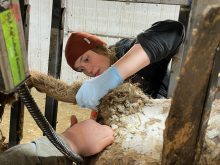The COVID-19 pandemic is likely to go down in history as the defining public health event of our lifetime.
The issue of antimicrobial resistance will too, albeit it will be remembered as more of a slow burn rather than an explosive event.
Bacteria resistant to antimicrobial drugs have been around since the first of these medications became available but we are fast approaching a time when simple infections may be untreatable.
Some bacteria are inherently resistant to medications — for instance, penicillin attacks the cell wall and only works to kill certain bacteria that have that feature. But the majority of resistance emerges from the use of these antimicrobial drugs.
Read Also

Canadian Food Inspection Agency slammed for handling of bovine tuberculosis case
The federal government leans heavily on producers to “take one for the team” and risk their livelihoods without any reassurance of support.
These drugs apply evolutionary selection pressure on bacteria so that susceptible strains die as expected but those strains that survive tend to proliferate, forming resistant populations.
Bacteria are also promiscuous with their genetic material and frequently swap DNA. This allows factors that enhance resistance to spread rapidly among even diverse bacterial species that were previously amenable to antimicrobial treatments.
Even more alarming are the bacterial strains that acquire resistance to different types of drugs, leading to multi-drug resistant bacteria that shrug off most available treatments.
When it comes to the issue of antimicrobial resistance in horses, probably the best studied bacterium is methicillin resistant Staphylococcus aureus (MRSA), one of the most common of what’s often called superbugs.
Many horses carry MRSA bacteria in their nose without signs of disease, but they can be a source of infection for other horses, either directly or through contaminated objects. People can also pick up this bacterium from carrier horses. Indeed, there are documented cases where MRSA was passed from horses to people in an equine hospital setting.
Given the opportunity, it can establish infections that may be challenging to treat. MRSA is most often associated with soft tissue infections, such as wounds or surgical incision infections, particularly in large equine hospital settings.
MRSA has also been implicated in bone and joint infections in horses. I was involved with a study in 2009 that swabbed normal, healthy horses in Western Canada for MRSA bacteria. We found that slightly more than one percent carried it in their noses without causing illness. But of course, its presence could have been bad for other horses in the herd if they were to develop an infection with it.
Another example where resistant bacteria can cause severe disease is Pseudomonas infections in eyes. Ulcers of the cornea (outer layer of the eye) can become infected with this bacterium and if it has resistance, treatment options may be limited.
Horses may acquire resistant bacteria in the same way they acquire other infections — passed from horse to horse either through direct contact between horses or from contaminated objects.
Sometimes horses pick up bacteria from people, as is the case sometimes with MRSA. But available research generally points to two main risk factors. The first is treatment with antimicrobial drugs. The second factor is hospitalization — for various reasons horses in hospitals are more likely to pick up resistant bacteria than the general horse population.
A key approach to limiting antimicrobial resistance in all animal species (and people) is to use antimicrobials responsibly. This includes treating known bacterial infections (the drugs don’t work on viruses or fungi). It is important to select the most appropriate antimicrobial drug for the infection type.
Whenever possible, treatment should be based on laboratory testing that includes bacterial culture to identify the species and tests to determine if the bacteria are sensitive or resistant to commonly used antimicrobial drugs. The medication should be administered for the full treatment regime to ensure infection is completely cleared before ceasing medication. Stopping an antimicrobial treatment too early can lead to resistance developing in the surviving bacteria.
Finally, whenever possible, infections should be treated with local medication, such as treating an eye infection with an antimicrobial eye ointment rather than giving injectable drugs.
Generally, the issue of antimicrobial resistance in horses has been less studied compared to other animal populations and people. This is an issue for human and animal health that will be with us for the foreseeable future.















